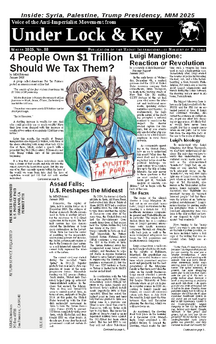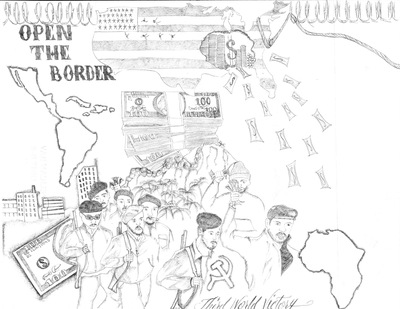RCP=U$A chair Bob Avakian once again sets his sails towards billowy
clouds in the May 29, 2011 issue of ‘Revolution’ newspaper, the official
mouthpiece of the rcp=u$a, in which the party leader once more makes the
case for a socialist revolution in the U.$. with the labor aristocracy
at the helm. He puts forth this idea in a talk broken down into series
of articles titled: “Birds cannot give birth to crocodiles, but humanity
can soar beyond the horizon.” He states that: “…in imperialist countries
in particular it is only with major qualitative change in the situation
- that is, the eruption of a revolutionary crisis and the emergence of a
revolutionary people in the millions and millions - that it becomes
possible to wage the all out struggle for the seizure of power…”
To begin with, it is important that we point out that socialist
revolution will not reach the bastions of imperialism until the Third
World proletariat and peasantry rises in the billions to first eject the
imperialists, subsequently defeating the compradors and then mobilizing
itself to smash the imperialists on their home turf with the help of the
oppressed nation lumpen of the internal semi-colonies. These oppressed
nation lumpen who are currently situated within the internal
semi-colonies, i.e. barrios/ghettos/reservations of amerika and it’s
prisons, are the only people in the U.$. with any kind of revolutionary
potential whatsoever!
So we don’t know where all these “millions of millions” of revolutionary
people that Avakian loves to harp about will be drawn from, unless he’s
counting on the labor aristocracy to take up arms and call itself
“comrade.”
Something else worth nothing here in the chairman’s flawed war thesis,
if you could even call it that, is that this economist/opportunist
deviation is not just owed to the RCP’s failure to acknowledge the
outcome of a proper class analysis, but also, because of their erroneous
line on the self-determination rights of the oppressed nations. The
rcp-u$a’s line is that all nationalism is bourgeoisie, hence
reactionary. More pointedly they don’t think there’s any nations within
the United $tates that need liberating, with a
possible
exception for the Black Nation.
The party leader goes on to talk about how important it is for the
struggle not to settle into “protractedness” because according to
Avakian “that would very much be a recipe for defeat.” The chairman then
makes some completely ludicrous and out of context comparisons when he
describes how the Maoist concept of a protracted Peoples War is no
longer a viable solution in the Third World and certainly is not suited
for U.$. conditions. Well, he’s certainly right that in regards to the
United $tates this is not a viable solution. However, with respect to
the former, Avakian attributes this to a lack of “finiteness” in the
struggle, instead, pushing for one big decisive battle. I assume here
that Mr. Avakian is referring to the now defunct Maoist struggles of
Nepal and Tamil of which the rcp=u$a has been very critical.
The fact that the rcp=u$a would denigrate various revolutionary Third
World struggles as “too much of things unto themselves” (which is also a
common rcp-u$a criticism of the Chinese Cultural Revolution) is a
straight up disrespect to the Third World masses dying daily at the
hands of imperialism and it’s comprador cartels, as well as
delegitimizing to the real science of revolutions: M-L-M.
No Mr. Avakian, the fact that the Nepalese and Tamil struggle has not
brought the proletariat victory has nothing to do with the failure of
the Maoist concept of a protracted peoples war, rather failure in these
struggles can be directly linked to revisionist leadership of the
rcp-u$a sort!
Continuing with this bourgeois-centric analysis, the party leader then
goes into some detail concerning the crucialness of public opinion
building and cultural work in general when it comes to preparing the
“masses” for revolution. However, and this is where you have to watch
him, he gets sneaky and besides already counting the labor aristocracy
as proletariat, he attempts to smuggle broad sections of the
petit-bourgeoisie into the revolution and eventually the dictatorship,
thereby killing the dictatorship of the proletariat before it’s ever
even born. This is what he says: “there is also, very importantly, the
problem of the development of the necessary political and ideological
conditions for the initiation of this struggle for the seizure of power
- and the organized expression of the political and ideological
influence of the vanguard - among the basic masses but also, to the
greatest degree possible at every point along the way, among other
strata of the people as well, in order to have the best possible basis
for carrying forward the struggle for power once it has been launched
and not, in fact to be contained and crushed, but to have the best
possible basis to ‘break out of encirclement.’”
It is true, historically speaking, that once socialist revolutions had
begun and proletarian victory was within reach, hoards of the enemy
class have come over to the side of the revolution. However, it has
never been the intent of the vanguard to focus their efforts so
ferociously on the enticement of parasites as Afakian and the rcp-u$a so
incessantly advocate for. It was however and remains so the principal
task of the revolutionaries, to unite all who can be united, i.e. the
truly oppressed and exploited.
If sections of the bourgeoisie so wish to either, (a) commit class
suicide and join the revolution or (b) see that victory is inevitable
for the proletariat and it’s allies and decide it better to be on the
winning side of the war, then so much the better. But neither Marx nor
Engels, Lenin, Stalin or Mao ever sought to actively recruit pigs who
were not dedicated to the revolution and neither should we.
If anything, the “middle” and “broad strata” would only be too happy to
swell the ranks of the imperialists armed forces and smash the internal
semi-colonies to pieces; they know which side their bread is buttered
on.
Indeed, seasoned readers of Kautsky’s, I mean Afakian and the RCP’s vile
distortions of M-L-M have come to understand that whenever Avakian and
company casually, indirectly or directly throw out the terms “middle”
and “broad strata” what they’re really trying to emphasize is the
reliance and inclusion of the bought off traitorous sections of the
population into and with the revolution. Notice how they consciously
exclude the true element of change from the equation the Third World
masses.
The rest of the chairman’s article basically rehashes some of the points
already made such as work in the cultural sphere prior to and during the
seizure of power, the importance of the “one, two, knockout blow” to the
bourgeoisie which serves to counteract the problem of “finiteness.” And
of course, he can’t emphasize enough the reliance of the revolution on
the “middle” and “broad strata”. And oh yea his deep lamentations that
white people have been turned against the oppressed by way of
propaganda, and all that’s needed for their return to the side of the
revolution is arduous public opinion building.
It is fitting that Bob Avakian’s piece is concluded by his making
companions between Mao’s China, pre-liberation and the United $tates
today, drawing parallels between the middle strata of the revolutionary
base areas in the Chinese countryside (the better off peasants) and the
decadent labor aristocracy which the rcp-u$a knows and loves today.
Truly, Bob Avakian is delusional.
MIM(Prisons) adds: For more on this topic check out other
articles on the
rcp=u$a and our analysis of the
labor
aristocracy in the First World.






 Alabama
Alabama
 Alaska
Alaska
 Arizona
Arizona
 Arkansas
Arkansas
 Army Post
Army Post
 California
California
 Colorado
Colorado
 Connecticut
Connecticut
 Delaware
Delaware
 District of Columbia
District of Columbia
 Federal
Federal
 Florida
Florida
 Georgia
Georgia
 Guam
Guam
 Hawaii
Hawaii
 Idaho
Idaho
 Illinois
Illinois
 Indiana
Indiana
 Iowa
Iowa
 Kansas
Kansas
 Kentucky
Kentucky
 Louisiana
Louisiana
 Maine
Maine
 Maryland
Maryland
 Massachusetts
Massachusetts
 Michigan
Michigan
 Minnesota
Minnesota
 Mississippi
Mississippi
 Missouri
Missouri
 Montana
Montana
 Nebraska
Nebraska
 Nevada
Nevada
 New Hampshire
New Hampshire
 New Jersey
New Jersey
 New Mexico
New Mexico
 New York
New York
 North Carolina
North Carolina
 North Dakota
North Dakota
 Ohio
Ohio
 Oklahoma
Oklahoma
 Oregon
Oregon
 Pennsylvania
Pennsylvania
 Puerto Rico
Puerto Rico
 Rhode Island
Rhode Island
 South Carolina
South Carolina
 South Dakota
South Dakota
 Tennessee
Tennessee
 Texas
Texas
 Utah
Utah
 Vermont
Vermont
 Virginia
Virginia
 Washington
Washington
 West Virginia
West Virginia
 Wisconsin
Wisconsin
 Wyoming
Wyoming

